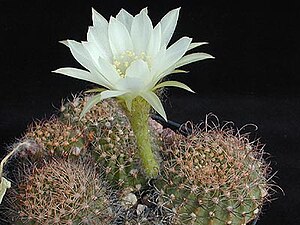Echinopsis ancistrophora
| Echinopsis ancistrophora | ||||||||||||
|---|---|---|---|---|---|---|---|---|---|---|---|---|

Echinopsis ancistrophora |
||||||||||||
| Systematics | ||||||||||||
|
||||||||||||
| Scientific name | ||||||||||||
| Echinopsis ancistrophora | ||||||||||||
| Speg. |
Echinopsis ancistrophora is a species of the genus Echinopsis in the cactus family(Cactaceae). The specific epithet ancistrophora is derived from the Latin words ankistron for 'hook' or 'barbed hook' and -phoros for 'supporting' and refers to the hooked thorns of the species.
description
Echinopsis ancistrophora grows individually or forms cushions. The depressed spherical, shiny dark green shoots reach a diameter of up to 8 centimeters. There are 15 to 20 straight ribs that are divided into numerous small cusps. The mostly single light brown central spine , sometimes up to four are present, occasionally it is missing, is hooked and up to 2 centimeters long. The three to ten bendable, whitish radial spines are spread out, slightly bent back into claws and have lengths of up to 1.5 centimeters.
The short to long funnel-shaped flowers appear laterally and open during the day or at night. They are 6 to 16 inches long. The flowers smell or are odorless and different in color - from white (sometimes tinged with pink) to deep red. The elongated, green to greenish purple fruits are somewhat dry. They are up to 1.6 centimeters long and have a diameter of 0.8 centimeters.
Distribution, systematics and endangerment
Echinopsis ancistrophora is distributed in the south of Bolivia and in the north of Argentina at altitudes of 600 to 2500 meters.
The first description by Carlos Luis Spegazzini was published in 1905.
Nomenclatory synonyms are Lobiviopsis ancistrophora (Speg.) Frič (1935, nom. Inval. ICBN -Article 34.1), Pseudolobivia ancistrophora (Speg.) Backeb. (1942) and Mesechinopsis ancistrophora (Speg.) Y.Itô (1957).
Subspecies
The following subspecies are distinguished:
- Echinopsis ancistrophora subsp. ancistrophora
- Echinopsis ancistrophora subsp. arachnacantha (Buining & F.Ritter) intoxication
- Echinopsis ancistrophora subsp. cardenasiana (intoxication) intoxication
It has not yet been finally clarified whether these three subspecies should be treated better as species.
Echinopsis ancistrophora subsp. ancistrophora
The subspecies is common in the Bolivian Department of Tarija and the Argentine provinces of Jujuy , Salta and Tucumán at low altitudes. The shoots are rather finely ribbed. The white, fragrant, 12 to 16 centimeters long flowers more or less always open at night.
Echinopsis ancistrophora subsp. arachnacantha
The subspecies is distributed in the Bolivian departments of Cochabamba and Santa Cruz at altitudes of 2400 to 2800 meters. Their depressed spherical, often sprouting shoots reach a diameter of up to 4 centimeters. The broad, funnel-shaped flowers are open during the day. They are yellow, orange, or red and 5 to 6 inches long. The first description as Lobivia arachnacantha was published in 1956 by Albert Frederik Hendrik Buining and Friedrich Ritter . Walter Rausch introduced the species in 1976 as a subspecies to Echinopsis ancistrophora . A nomenclature synonym is Echinopsis arachnacantha (Buining & F.Ritter) H. Friedrich (1974).
Echinopsis ancistrophora subsp. cardenasiana
The subspecies is common in the Bolivian department of Tarija. Their rather coarsely ribbed shoots have a diameter of up to 10 centimeters. The violet-pink to red, up to 10 centimeters long flowers that are open during the day are opposite to Echinopsis ancistrophora subsp. ancistrophora a little shorter and more compact. It was first described as Lobivia cardenasiana in 1972 by Walter Rausch. Four years later he introduced the species as a subspecies to Echinopsis ancistrophora . A nomenclature synonym is Echinopsis cardenasiana (Rausch) H. Friedrich (1974).
In the Red List of Threatened Species of IUCN is the species as " Vulnerable (VU) ", d. H. listed as endangered. The subspecies Echinopsis ancistrophora subsp. arachnacantha is recognized as a species and as " Least Concern (LC) ", i. H. listed as not endangered.
proof
literature
- Edward F. Anderson : The Great Cactus Lexicon . Eugen Ulmer KG, Stuttgart 2005, ISBN 3-8001-4573-1 , p. 216-217 .
Individual evidence
- ↑ Urs Eggli, Leonard E. Newton: Etymological Dictionary of Succulent Plant Names . Springer, Berlin / Heidelberg 2010, ISBN 978-3-642-05597-3 , p. 10.
- ↑ Carlos Luis Spegazzini: Cactacearum Platensium Tentamen . In: Anales del Museo Nacional de Buenos Aires . 3rd Series, Volume 4, 1905, pp. 492-493 (online) .
- ↑ Martin Lowry: Echinopsis . In: Cactaceae Systematics Initiatives . Volume 13, 2002, pp. 16-17.
- ^ Succulenta . 1956, p. 37.
- ^ A b Walter Rausch: Lobivia. The diurnal Echinopsidinae from an arelgeographic point of view . Vienna 1976, p. 140.
- ↑ Cacti and other succulents . Volume 23, Number 2, 1972, p. 32.
- ↑ Heimo Friedrich : Cacti and other succulents . Volume 25, Number 4, 1974, p. 82.
- ↑ Echinopsis ancistrophora in the IUCN Red List of Threatened Species 2013.2. Posted by: Ortega-Baes, P. & Lowry, M., 2010. Retrieved February 23, 2014.
- ↑ Echinopsis arachnacantha in the Red List of Threatened Species of the IUCN 2013.2. Posted by: Lowry, M., 2010. Retrieved February 23, 2014.